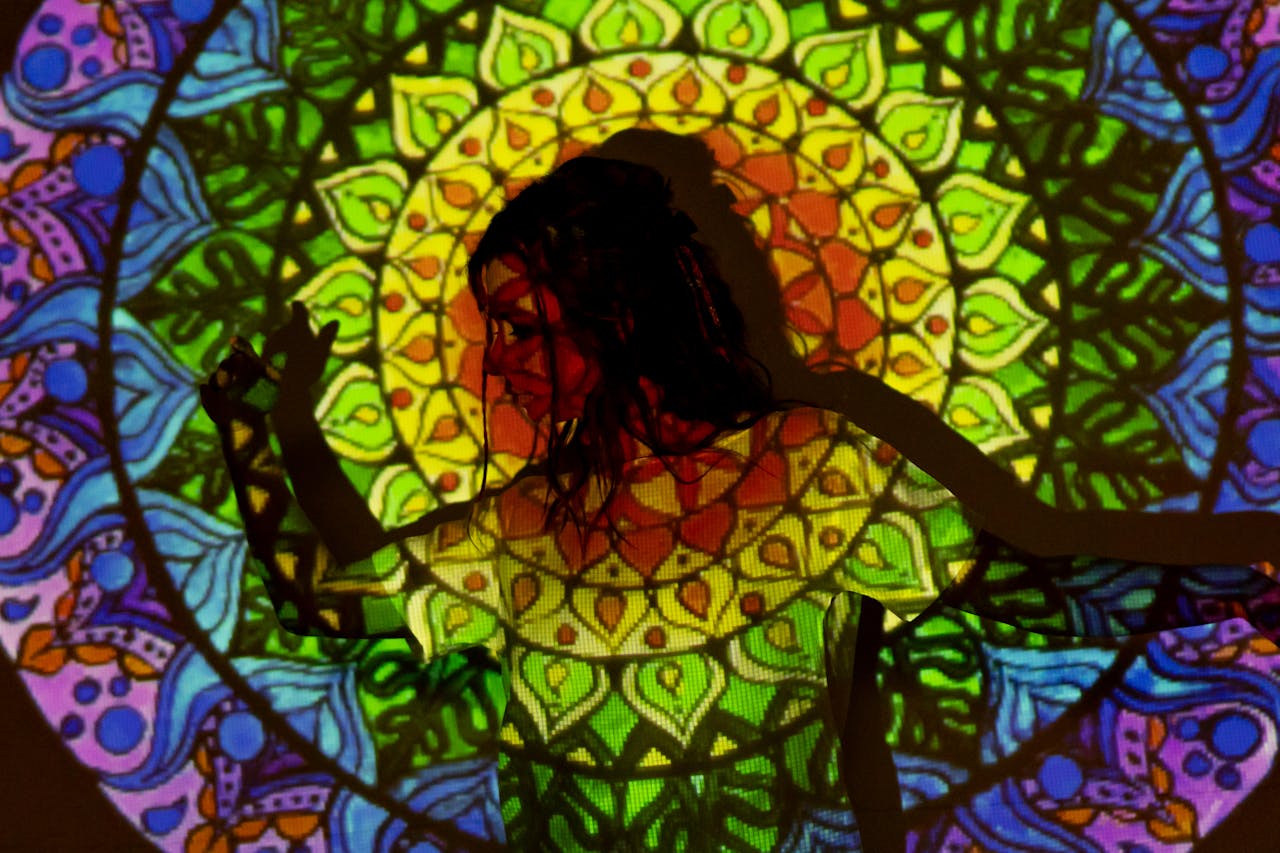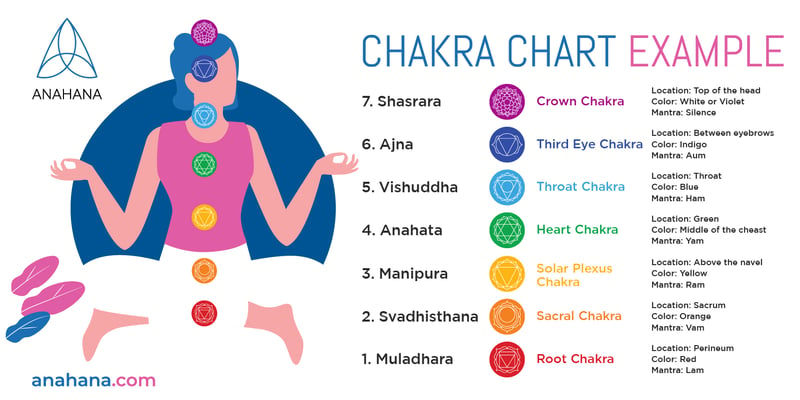
Table of Contents
Explore a comprehensive chakra chart for practical insights into the body's energy system. This guide offers straightforward explanations of each chakra's significance and associated attributes, aiding in understanding and balancing your energy flow. Elevate your holistic well-being with this overview of chakras and their transformative potential.
What Is a Chakra Chart?
Chakra charts include only the most important information on each chakra energy center. The Sanskrit word “chakra” translates to “wheel,” representing the seven chakras as spinning wheels of energy moving together.
Each of the seven chakras has its own symbol, color, and other correlating elements that inform this energy. These affect one’s mental, physical, and spiritual well-being differently.
By understanding the details, you can tune into the chakra system regularly, helping the energy flow within the physical body.
Structure of the Chakra Chart
A comprehensive, wonderful chakra chart should include specific details regarding each chakra. Each chart will look different, and one will only give them the most important information. Starting from the base up, the seven major chakras may include:
- Name of the chakra
- Chakra location
- Chakra colors
- Chakra crystals and stones
- Sanskrit names of all chakras
- Meaning of the Sanskrit name
- The element associated with all energy centers
- Functions of each chakra
- Seed sounds of each chakra
- Affirmation to activate it
- Chakra imbalance (blockage) symptoms
- Few creative ideas on how to unblock each chakra
- Essential oils
- Yoga poses
Seven Chakras: What are They?
Root Chakra
The Root Chakra is associated with the earth element and focuses on grounding, providing foundation and stability to the entire chakra system. Its Sanskrit meaning is root support, which lives at the spine's base.
Symptoms of a blocked Root Chakra include feeling uneasy and unbalanced or lacking natural human instincts. The chakra color is red, and stones, including red jasper, help balance one’s base. Essential oils, including allspice and rosemary, can provide grounding energy.
Sacral Chakra
The Sacral Chakra is located in the lower abdomen and holds power for people’s creativity, passion, and sexual organs. It is all about feeling the energy to cultivate one’s purpose and become a better self.
Symptoms of a blocked Sacral Chakra include codependency, feeling overwhelmed, and isolation. The chakra color orange, blood orange essential oils, and orange stones (including orange calcite) help inform sacral chakra healing.
Solar Plexus Chakra
The Solar Plexus Chakra sits at our core and is the center of one’s power. A functioning Solar Plexus Chakra helps people feel confident and empowered, but when blocked, one may feel powerless, hopeless, and inferior.
The chakra color yellow informs the chakra, relating to stones such as Amber and Tiger’s Eye and essential oils, including mint. The Solar Plexus Chakra helps us push ourselves to complete the most challenging yoga poses and face difficult circumstances in life.
Heart Chakra
Represented by the chakra color green, the Heart Chakra lives in the chest. It connects to feeling compassion and love for oneself and others around them and may be out of balance if grief, jealousy, or hatred dominate.
The Heart Chakra is the bridge that connects the lower chakras and the material domain to the upper chakras and the spiritual realm. Pink and green stones, including Rose Quartz, and essential oils, including cilantro and thyme, are excellent for balancing the Heart Chakra.
Throat Chakra
Research confirms that there is non-verbal energy that we cultivate through communication. The Throat Chakra is all about communication and its energy, supporting the human ability to speak with wisdom and truth.
Chronic lying or inability to express one’s thoughts are signs of a blocked Throat Chakra, while physical symptoms can include a sore throat and thyroid imbalance.
Blue informs this chakra, which can also be stimulated through blue crystals and stones and diffusing eucalyptus. The mantra “I speak” effectively unlocks the Throat Chakra energy.
Third Eye Chakra
The Third Eye Chakra has been called one’s sixth sense. Located on the forehead between and above the eyes, it provides insight and intuition regarding our own inner world and the world around us. When blocked, this energy causes confusion and brain fog.
By maintaining balance in one’s life, the Third Eye Chakra will be open with awareness and wisdom. Indigo informs this chakra, and Lapis Lazuli stones and cypress oils in the center of the brow can help with spirituality.
Crown Chakra
The Crown Chakra is located at the very top of the head. It resides at the body's highest point, connecting one outward into the energy of the whole universe, informing one’s connection to the divine or spirit, and reaching a state of higher consciousness.
Chakra Chart Example

How to Use a Chakra Chart
Using a handy chakra chart is like having a roadmap for your body's human energy field, guiding you toward better balance and well-being. Here’s how you can make the most of all the essential information:
- Get to Know the Chakras: Start by getting familiar with the seven main chakras: Root, Sacral, Solar Plexus, Heart, Throat, Third Eye, and Crown. Look at their locations, colors, and the aspects of life they influence. This basic knowledge is your foundation.
- Spot Areas Needing Work: Reflect on how you’re feeling lately—both physically and emotionally—to figure out which chakras might be off-kilter. For instance, if stress about your work performance is your constant companion, your Solar Plexus Chakra might need attention and care.
- Set Your Healing Intentions: Decide which chakras you want to focus on balancing and identify why. You might develop affirmations or specific goals for opening and healing these energy centers.
- Pick Chakra-Centric Practices: Use the chart to help choose activities that can help balance your chakras, such as specific yoga poses, meditation techniques, or even lifestyle changes that align with the energy of each chakra.
- Try Crystals and Aromatherapy: The chart might also suggest crystals and essential oils for each chakra. Amethyst can be a powerful ally for intuition and Rose Quartz for love. You can keep these crystals close or use the oils during meditation for an extra boost.
- Keep Checking In: Regularly return to the chakra chart to see how you’re doing and if your focus needs to shift. Balancing chakras is an ongoing process, and what you need might change over time.
- Seek Advice When Needed: If you’re unsure about your progress or how to tackle a particular issue, don’t hesitate to contact a professional who can offer tailored advice.
Using a chakra chart isn’t just about spiritual health; it’s a holistic approach to feeling more aligned and balanced in every part of your life. Take it step by step, and you’ll notice the shifts within yourself.
Frequently Asked Questions
Can a chakra chart assist in identifying blocked chakras?
Yes, a chakra chart can be useful in identifying blocked chakras by providing information on the physical and emotional manifestations of imbalance within each chakra.
By comparing these symptoms with your own experiences, you can pinpoint which chakras may be blocked and require focused healing practices.
It’s advisable to develop your inner sense of the health of your chakras through meditation, for example, but a chart can guide you as you develop this self-awareness.
Is there a difference between traditional and modern chakra charts?
Traditional chakra charts are based on ancient texts and emphasize each chakra's spiritual and holistic aspects, including their Sanskrit names, bija mantras, and associated deities.
Modern chakra charts might incorporate contemporary interpretations and applications, focusing more on psychological and physical health aspects, making the concept more accessible to people unfamiliar with Eastern spirituality.
References
7 Chakras Charts For Beginners
What is a Chakra Chart & How Do You Use It
Chakra Chart - all the essential Information at a glance - 7wisdoms.org
A Brief History of the Chakras in Human Body
Disclaimer
The contents of this article are provided for informational purposes only and are not intended to substitute for professional medical advice, diagnosis, or treatment. It is always recommended to consult with a qualified healthcare provider before making any health-related changes or if you have any questions or concerns about your health. Anahana is not liable for any errors, omissions, or consequences that may occur from using the information provided.

By: Meriah McCauley
Meriah McCauley is a leading voice in holistic healing, known across North America for her expertise in chakra balancing, spiritual alignment, and energy-based wellness. Her work bridges the art and science of mind-body healing, shaped through years of study, practice, and mentorship. Meriah deepened her understanding of spiritual anatomy and the chakra system under the guidance of her guru, Dr. Don Stapleton, during her immersive training in Costa Rica. She later earned her Master’s degree in Psychology from Columbia University, specializing in Spirituality and the Mind–Body connection, which continues to influence her integrative approach. Today, she supports individuals and practitioners through coaching, yoga teacher trainings, chakra-focused education, and Holotropic Breathwork for personal transformation. Meriah is dedicated to helping others develop emotional clarity, energetic balance, and spiritual resilience—and she remains committed to guiding anyone seeking a deeper, more meaningful connection with themselves.